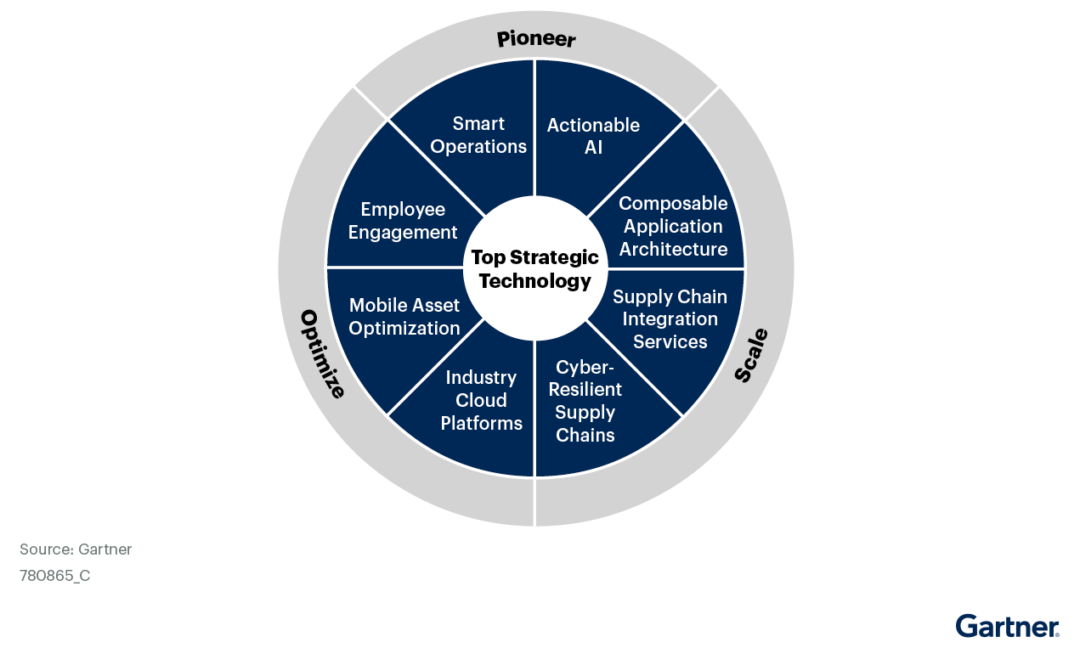Gartner forecasts 8 supply chain technology trends for 2023
CSCOs seek new engagement, optimized resilience, and scaled performance.

Chief supply chain officers (CSCOs) across global markets are seizing an opportunity to create growth through new investments, highlighted by a list of eight top supply chain technology trends for 2023, the consulting firm Gartner said today.
The analysis comes from a survey of 499 supply chain leaders from October through December 2022 in North America, Latin America, Western Europe, and the Asia/Pacific region. Those results show that 65% of respondents said they anticipate it will be easier to fund new technology investments this year, with 73% of supply chain IT budgets slated to be allocated to growth and performance enhancements.
“The last three years of uncertainty have blurred the line between business and technology strategies to the point that they must be considered together,” Simon Jacobson, VP Analyst in Gartner’s Supply Chain Practice, said in a release. “Supply chain leaders must have an understanding of the strategic, disruptive, and unavoidable technologies that will impact their planning processes over the next five years.”
In response, three key motivations among supply chain leaders will help to categorize this year’s technology trends: to pioneer new forms of engagement, optimize for resilience, and scale performance that enables technology to be delivered “any place and any time,” Jacobson said.
According to its research, Gartner forecasts that the top supply chain technology trends for 2023 include eight categories:
1. Actionable AI. Actionable AI delivers better data-driven decisions by mimicking the problem solving that humans make by augmenting decisions and keeping humans in the loop for validation purposes. Actionable AI learns patterns based off past decisions and experiences to adapt to changing, real world circumstances. Solutions continuously retrain models and learn within the runtime and development environments based on new data.
2. Smart Operations. Smart operations extends the preexisting concept of smart manufacturing to encompass all core operational capabilities, including manufacturing, service and logistics that span warehousing, transportation and global trade. This involves the orchestration of a web of different and distributed processes and the underlying systems and data that support them. While manufacturing is ahead in pursuing smart operations, logistics organizations are rapidly embracing the potential of this idea to transform their businesses.
3. Mobile Asset Optimization. Mobile asset optimization maximizes the use of an enterprise’s mobile assets by combining business process software, sensory technologies, and operational research techniques for optimization and business intelligence. This has implications inside the warehouse where intralogistics smart robots are garnering attention and investment. Outside, transportation visibility platforms can show carrier activity and capacity improving collaboration between shippers, carriers and logistics providers.
4. Industry Cloud Platforms. Industry cloud platforms combine software as a service (SaaS), platform as a service (PaaS), and infrastructure as a service (IaaS) with specific functionality for vertical industry use cases. They do so not as predefined, one-off, vertical SaaS solutions, but rather as agile composable platforms supported by a catalog of industry-specific packaged business capabilities. In effect, they turn a cloud platform into a business platform and expand a technology innovation tool into one that also serves as a business innovation tool, creating added value beyond traditional cloud approaches.
5. Employee Engagement. Employee engagement is broadly a set of tools and applications used to help companies improve frontline worker performance, satisfaction and retention. This trend can span mixed reality and mobile devices to provide content that augments the job, wearables for safety and location management, collaboration tools and more. These technology investments have to be anchored in a broader workforce strategy that spans knowledge curation, skills development and training.
6. Composable Application Architecture. Composable business applications are designed to follow the core design principles of modularity, autonomy, orchestration and discovery, with a specific business use case. These packaged business capabilities are encapsulated software components that represent a well-defined business capability, recognizable as such by an end user.
7. Cyber Resilient Supply Chains. As supply chains implement more advanced technologies, they add additional supply chain partners, vendors and service providers to their “digital” supply chain. However, each addition of an external entity to the digital enterprise represents additional digital connectivity and increased cybersecurity vulnerabilities and risks. Cybersecurity represents the tools, processes and governance methods (mechanisms) needed to mitigate cybersecurity risks caused by the extreme heterogeneity of supply chain technologies and ecosystem participants.
8. Supply Chain Integration Services. Supply chain integration services encompass technology platforms, integration teams, strategic decision making on which applications to connect when and how (different integration strategies), and finally, cloud services to manage these integrations. Supply chain integration services elevate the role of integration from a tactical, execution-centric and technical view of system interoperability to a strategy-led vision of a more-interconnected world.
Related Articles
Copyright ©2024. All Rights ReservedDesign, CMS, Hosting & Web Development :: ePublishing